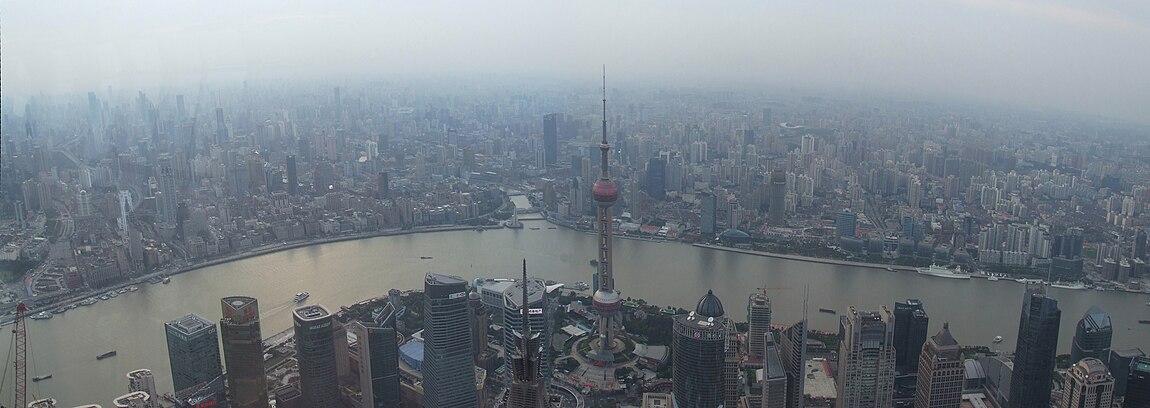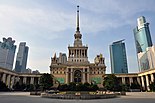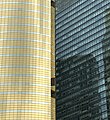SHANGHAI METRO MAP
 Shanghai Metro Map
Shanghai Metro Map
Here are 25 popular tourist attractions in Shanghai and the metro lines you can take from the city center:
-
The Bund (Line 2)
The Bund is a famous waterfront area located along the Huangpu River in Shanghai, China. It is considered to be one of the most iconic landmarks in the city and is a popular tourist destination.
The Bund has a rich history, dating back to the 19th century when Shanghai was a major center of commerce and trade. During this time, the area along the Huangpu River became home to numerous foreign consulates and banks, which built impressive colonial-style buildings that still stand today. This led to the area becoming known as “the Bund” which means “embankment.”
Over the years, the Bund has been a witness to some of the most significant events in Shanghai’s history, including the rise and fall of various empires, the impact of foreign powers, and the city’s transformation into a major global financial center. Today, the Bund continues to be a major attraction for tourists and locals alike, offering a unique blend of history and modernity.
- Yu Garden (Line 10 or Line 13)
-
Shanghai Tower (Line 2)
The Shanghai Tower is a skyscraper located in the Pudong district of Shanghai, China. It is the second tallest building in the world and the tallest in China, with a height of 632 meters (2,073 feet).
The construction of the Shanghai Tower began in 2008 and was completed in 2015. The tower was designed to be a symbol of Shanghai’s economic development and modernity, as well as a destination for businesses, tourists, and residents.
The tower features a unique twisting design that allows for maximum exposure to natural light and provides views of the surrounding city. The building also incorporates sustainable features such as energy-efficient systems, rainwater collection, and a green roof.
In addition to its office space, the Shanghai Tower also features a luxury hotel, a shopping mall, and a number of public observation decks that offer breathtaking views of the city. Since its completion, the Shanghai Tower has become one of the most recognizable landmarks in Shanghai and has attracted millions of visitors from around the world.
Shanghai Tower
| Shanghai Tower | |
|---|---|
|
上海中心大厦
Shànghǎi Zhōngxīn Dàshà |
|

Shanghai Tower in 2015
|
|

|
|
| Former names | Shanghai Center |
| General information | |
| Status | Completed |
| Type | Mixed-use |
| Location | 501 Yincheng Middle Rd, Lujiazui, Pudong, Shanghai |
| Coordinates | 31°14′08″N 121°30′04″ECoordinates: 31°14′08″N 121°30′04″E |
| Construction started | 21 November 2008 |
| Completed | 2 September 2014 |
| Opened | 2 February 2015 |
| Cost | ¥15.7 billion RMB |
| Owner | Shanghai Tower Construction and Development |
| Height | |
| Architectural | 632 m (2,073 ft) |
| Tip | 632 m (2,073 ft) |
| Top floor | 587.4 m (1,927 ft) (Level 127)[1] |
| Observatory | 562 m (1,844 ft) (Level 121)[9] |
| Technical details | |
| Floor count | 128 above ground 5 below ground |
| Floor area | 380,000 m2 (4,090,300 sq ft) above grade 170 m2 (1,800 sq ft) below grade |
| Lifts/elevators | 97, supplied by Mitsubishi Electric |
| Design and construction | |
| Architect(s) | Marshall Strabala & Jun Xia (Gensler) TJAD |
| Engineer | Thornton Tomasetti Cosentini Associates I.DEA Ecological Solutions |
| Main contractor | Shanghai Construction Group |
| References | |
| [2][3][4][5][6][7][8] | |
Shanghai Tower (simplified Chinese: 上海中心大厦; traditional Chinese: 上海中心大廈; pinyin: Shànghǎi Zhōngxīn Dàshà; Shanghainese: Zånhe Tsonsin Dusa; lit. ‘Shanghai Center Building’) is a 128-story, 632-meter-tall (2,073 ft) megatall skyscraper in Lujiazui, Pudong, Shanghai.[10] It is the tallest building in China and the world’s third-tallest building by height to architectural top. It is the tallest and largest LEED Platinum certified building in the world since 2015. It shares the record (along with the Ping An Finance Center) of having the world’s highest observation deck within a building or structure at 562 m.[11] It had the world’s second-fastest elevators at a top speed of 20.5 meters per second (74 km/h; 46 mph) until 2017,[12][13] when it was surpassed by the Guangzhou CTF Finance Center, with its top speed of 21 meters per second (76 km/h; 47 mph).[14] Designed by international design firm Gensler and owned by the Shanghai Municipal Government,[2] it is the tallest of the world’s first triple-adjacent supertall buildings in Pudong, the other two being the Jin Mao Tower and the Shanghai World Financial Center. Its tiered construction, designed for high energy efficiency, provides nine separate zones divided between office, retail and leisure use.[5][7][15]
Construction work on the tower began in November 2008[10] and topped out on 4 August 2013. The exterior was completed in summer 2015,[8][15] and work was considered complete in September 2014. Although the building was originally scheduled to open to the public in November 2014, the actual public-use date was shifted to February 2015. The observation deck was opened to visitors in July 2016; the period from July through September 2018 was termed a “test run” or “commissioning” period.[16][17] Since April 26, 2017, the sightseeing deck on the 118th floor has been open to the public.[18]
History
Planning and funding
Planning models for the Lujiazui financial district dating back to 1993 show plans for a close group of three supertall skyscrapers.[19] The first of these, the Jin Mao Tower, was completed in 1999; the adjacent Shanghai World Financial Center (SWFC) opened in 2008.[20]
The Shanghai Tower is owned by Yeti Construction and Development, a consortium of state-owned development companies which includes Shanghai Chengtou Corp., Shanghai Lujiazui Finance & Trade Zone Development Co., and Shanghai Construction Group.[2][6] Funding for the tower’s construction was obtained from shareholders, bank loans, and Shanghai’s municipal government.[21] The tower had an estimated construction cost of US$2.4 billion.[7]
Construction
In 2008, the site – previously a driving range[22] – was prepared for construction.[23][24] A groundbreaking ceremony was held on 29 November 2008, after the tower had passed an environmental impact study.[25] The main construction contractor for the project was Shanghai Construction Group, a member of the consortium that owns the tower.[6]
A repetitive slip-forming process was used to construct the tower’s core floor by floor.[26] By late April 2011, the tower’s steel reinforcement had risen to the 18th floor, while its concrete core had reached the 15th floor, and floor framing had been completed up to the fourth floor.[26] By late December 2011, the tower’s foundations had been completed, and its steel construction had risen above the 30th floor.[27] In the first months of 2012, cracks began appearing in the roads near the tower’s construction site. These were blamed on ground subsidence, which was likely caused by excessive groundwater extraction in the Shanghai area, rather than by the weight of the Shanghai Tower.[28]
By May 2012, the tower’s core stood 250 meters (820 ft) high, while floors had been framed to a height of 200 meters (660 ft).[29] By early September 2012, the core had reached a height of 338 meters (1,109 ft).[30] By the end of 2012, the tower had reached the 90th floor, standing approximately 425 meters (1,394 ft) tall.[31] By 11 April 2013, the tower had reached 108 stories, standing over 500 meters (1,600 ft) tall and thusly exceeding the heights of its two adjacent supertall skyscrapers, the Jin Mao Tower and the Shanghai World Financial Center.[32]
Construction crews laid the final structural beam of the tower on 3 August 2013, thus topping out the tower as China’s tallest, and the world’s second-tallest, building.[33][34] A topping-out ceremony was held at the site of the last beam.[33][35] During the ceremony, Gensler co-founder Art Gensler stated:
The Shanghai Tower represents a new way of defining and creating cities. By incorporating best practices in sustainability and high-performance design, by weaving the building into the urban fabric of Shanghai and drawing community life into the building, Shanghai Tower redefines the role of tall buildings in contemporary cities and raises the bar for the next generation of super-highrises.[36]
The principal architect of the project, Jun Xia, said: “With the topping out of Shanghai Tower, the Lujiazui trio will serve as a stunning representation of our past, our present, and China’s boundless future.”[36] Gu Jianping, general manager of the Shanghai Tower Construction Company, expressed the firm’s wish “to provide higher quality office and shopping space, as well as contribute to the completeness of the city skyline’s and the entire region’s functionality”.[34]
In January 2014, the tower’s crown structure passed the 600-meter (2,000 ft) mark when its construction entered its final phase.[37] The tower’s crown structure was completed in August 2014, and its façade was completed shortly after.[38] The tower’s interior construction and electrical fitting-out were completed in late 2014.[15][39][38] The opening was gradually introduced during the summer of 2015.[16]
2017 and later
Until June 2017, the tower faced problems attracting tenants due to the absence of all the necessary permits from the local fire department, and consequent impossibility of obtaining the official occupancy permit.[40]
Following a report in June 2017, approximately 60% of its office space has been leased, but only 33% of those tenants have moved in, leaving entire floors of the tower empty; the luxury J hotel has also yet to open. The tower’s floor plate has an “efficiency rate of only 50 per cent on some floors, compared with 70 per cent for a typical [skyscraper]”, as the tower’s “much-talked-about outer skin, which is ideal for allowing in natural light and cuts down on air-conditioning costs… means much of the floor space can’t be used”.[41] As of 2019, 55 floors stood empty.[42] Current tenants of the tower include Alibaba, Intesa Sanpaolo and AllBright Law Offices.[43]
In 2020, major water leaks broke out from the 60th to the 9th floor of the tower, which damaged a large quantity of office equipment and electronics. The tower said the problem was fixed and a comprehensive inspection would be taken on the floor where the leak originated. Some Chinese social media users criticized the leakage as typical of the results of tofu-dreg projects.[44] According to the local newspaper of Shanghai, misinformation videos circulating online showing that the tower’s ceiling was collapsed were in fact from a shopping center in Nanning in 2016.[45]
On June 19, 2021, the J Hotel Shanghai Tower opened.[46][47]
- Oriental Pearl Tower (Line 2)
- Shanghai World Financial Center (Line 2)
- Shanghai Disneyland (Line 11)
- Xintiandi (Line 10 or Line 13)
- Shanghai Museum (Line 1 or Line 10)
- Shanghai Circus World (Line 2)
- Shanghai Ocean Aquarium (Line 16)
- Shanghai Tower Observation Deck (Line 2)
- Jade Buddha Temple (Line 13)
- Shanghai Science and Technology Museum (Line 2)
- Shanghai Natural History Museum (Line 1)
- Shanghai Happy Valley (Line 7)
- Shanghai International Financial Center (Line 4)
- Shanghai Jewish Refugees Museum (Line 10)
- Shanghai World Expo Park (Line 8)
- Shanghai Urban Planning Exhibition Center (Line 2)
- Shanghai Dongjiadu Ferry Wharf (Line 16)
- Shanghai Art Museum (Line 1)
- Qibao Ancient Town (Line 9)
- French Concession (Line 1, Line 10 or Line 13)
- Longhua Temple (Line 3 or Line 4)
- Hongqiao Pearl Market (Line 2 or Line 10).
Cityscape
The Bund, located by the bank of the Huangpu River, is home to a row of early 20th-century architecture, ranging in style from the neoclassical HSBC Building to the Art Deco Sassoon House (now part of the Peace Hotel). Many areas in the former foreign concessions are also well-preserved, the most notable being the French Concession.[75] Shanghai is also home to many architecturally distinctive and even eccentric buildings, including the Shanghai Museum, the Shanghai Grand Theatre, the Shanghai Oriental Art Center, and the Oriental Pearl Tower. Despite rampant redevelopment, the Old City still retains some traditional architecture and designs, such as the Yu Garden, an elaborate Jiangnan style garden.[76]
As a result of its construction boom during the 1920s and 1930s, Shanghai has among the most Art Deco buildings in the world.[75] One of the most famous architects working in Shanghai was László Hudec, a Hungarian-Slovak who lived in the city between 1918 and 1947.[77] His most notable Art Deco buildings include the Park Hotel, the Grand Cinema, and the Paramount.[78] Other prominent architects who contributed to the Art Deco style are Clement Palmer and Arthur Turner, who together designed the Peace Hotel, the Metropole Hotel, and the Broadway Mansions;[79] and Austrian architect C.H. Gonda, who designed the Capitol Theatre. The Bund has been revitalized several times. The first was in 1986, with a new promenade by the Dutch architect Paulus Snoeren.[80] The second was before the 2010 Expo, which includes restoration of the century-old Waibaidu Bridge and reconfiguration of traffic flow.[81]

Site of the First National Congress of the Chinese Communist Party, a typical shikumen building in the former French Concession
One distinctive cultural element is the shikumen (石库门, “stone storage door”) residence, typically two- or three-story gray brick houses with the front yard protected by a heavy wooden door in a stylistic stone arch.[82] Each residence is connected and arranged in straight alleys, known as longtang[g] (弄堂). The house is similar to western-style terrace houses or townhouses, but distinguishes by the tall, heavy brick wall and archway in front of each house.[84]
The shikumen is a cultural blend of elements found in Western architecture with traditional Jiangnan Chinese architecture and social behavior.[82] Like almost all traditional Chinese dwellings, it has a courtyard, which reduces outside noise. Vegetation can be grown in the courtyard, and it can also allow for sunlight and ventilation to the rooms.[85]
Some of Shanghai’s buildings feature Soviet neoclassical architecture or Stalinist architecture, though the city has fewer such structures than Beijing. These buildings were mostly erected between the founding of the People’s Republic in 1949 and the Sino-Soviet Split in the late 1960s. During this time period, large numbers of Soviet experts, including architects, poured into China to aid the country in the construction of a communist state. An example of Soviet neoclassical architecture in Shanghai is the modern-day Shanghai Exhibition Center.[86]
Shanghai—Lujiazui in particular—has numerous skyscrapers, making it the fifth city in the world with the most skyscrapers.[87] Among the most prominent examples are the 421 m (1,381 ft) high Jin Mao Tower, the 492 m (1,614 ft) high Shanghai World Financial Center, and the 632 m (2,073 ft) high Shanghai Tower, which is the tallest building in China and the second tallest in the world.[88] Completed in 2015, the tower takes the form of nine twisted sections stacked atop each other, totaling 128 floors.[89] It is featured in its double-skin facade design, which eliminates the need for either layer to be opaqued for reflectivity as the double-layer structure has already reduced the heat absorption.[90] The futuristic-looking Oriental Pearl Tower, at 468 m (1,535 ft), is located nearby at the northern tip of Lujiazui.[91] Skyscrapers outside of Lujiazui include the White Magnolia Plaza in Hongkou, the Shimao International Plaza in Huangpu, and the Shanghai Wheelock Square in Jing’an.
-
The Shanghai Museum
-
The Shanghai Exhibition Center, an example of Stalinist architecture
-
The Oriental Pearl Tower at night
Note: These metro lines may change depending on the current situation in Shanghai.
The Shanghai Metro Map (Chinese: 上海地铁; pinyin: Shànghǎi Dìtiě) is a rapid transit system in Shanghai, operating urban and suburban transit services to 14 of its 16 municipal districts[d] and to Kunshan, Jiangsu Province. Served as a part of Shanghai rail transit, the Shanghai Metro Map system is the world’s biggest metro system by route length, totaling 802 kilometres (498 mi).[5][c] It is also the second biggest by the number of stations with 396 stations on 19 lines.[a][b] It ranks second in the world by annual ridership with 3.88 billion rides delivered in 2019.[1] The daily ridership record was set at 13.29 million on March 8, 2019.[2] Over 10 million people use the system on an average workday.
History Shanghai Metro Map
Main article: Timeline of Shanghai Metro line opening
Evolution of the Shanghai Metr
Lines
For the maglev train and current and future commuter rail services, see Shanghai maglev train, Jinshan railway, and Shanghai Metropolitan Area Intercity Railway.
In service
There are currently 19 lines in operation, with lines and services denoted numerically as well as by characteristic colors, which are used as a visual aid for better distinction on station signage and on the exterior of trains, in the form of a colored block or belt.
Most tracks in the Shanghai Metro system are served by a single service; thus “Line X” usually refers to both the physical line and its service. The only exception is the segment shared by lines 3 and 4, between Hongqiao Road station and Baoshan Road station, where both services use the same tracks and platforms.












